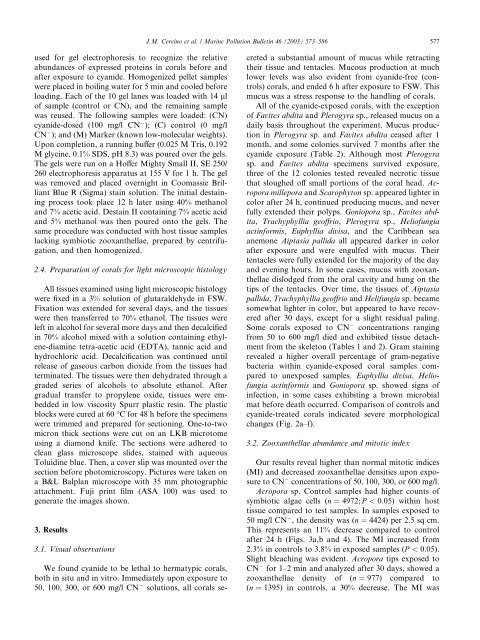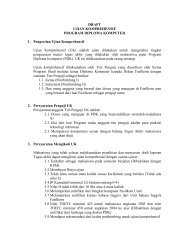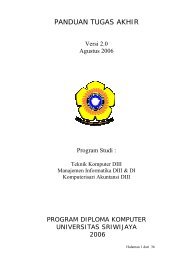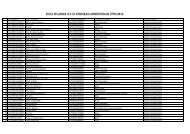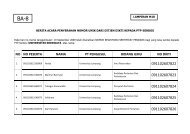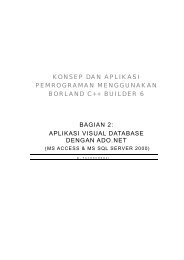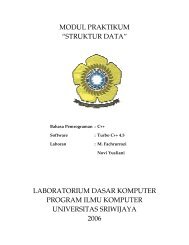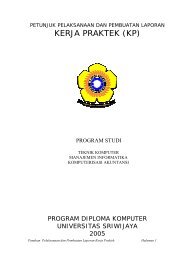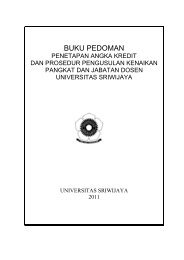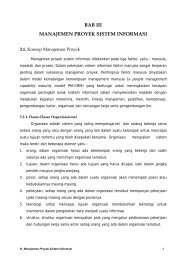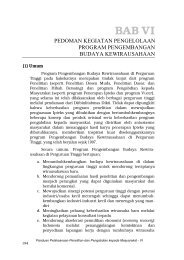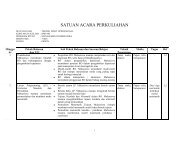Changes in zooxanthellae density, morphology, and mitotic index in ...
Changes in zooxanthellae density, morphology, and mitotic index in ...
Changes in zooxanthellae density, morphology, and mitotic index in ...
Create successful ePaper yourself
Turn your PDF publications into a flip-book with our unique Google optimized e-Paper software.
J.M. Cerv<strong>in</strong>o et al. / Mar<strong>in</strong>e Pollution Bullet<strong>in</strong> 46 (2003) 573–586 577<br />
used for gel electrophoresis to recognize the relative<br />
abundances of expressed prote<strong>in</strong>s <strong>in</strong> corals before <strong>and</strong><br />
after exposure to cyanide. Homogenized pellet samples<br />
were placed <strong>in</strong> boil<strong>in</strong>g water for 5 m<strong>in</strong> <strong>and</strong> cooled before<br />
load<strong>in</strong>g. Each of the 10 gel lanes was loaded with 14 ll<br />
of sample (control or CN), <strong>and</strong> the rema<strong>in</strong><strong>in</strong>g sample<br />
was reused. The follow<strong>in</strong>g samples were loaded: (CN)<br />
cyanide-dosed (100 mg/l CN ); (C) control (0 mg/l<br />
CN ); <strong>and</strong> (M) Marker (known low-molecular weights).<br />
Upon completion, a runn<strong>in</strong>g buffer (0.025 M Tris, 0.192<br />
M glyc<strong>in</strong>e, 0.1% SDS, pH 8.3) was poured over the gels.<br />
The gels were run on a Hoffer Mighty Small II, SE 250/<br />
260 electrophoresis apparatus at 155 V for 1 h. The gel<br />
was removed <strong>and</strong> placed overnight <strong>in</strong> Coomassie Brilliant<br />
Blue R (Sigma) sta<strong>in</strong> solution. The <strong>in</strong>itial desta<strong>in</strong><strong>in</strong>g<br />
process took place 12 h later us<strong>in</strong>g 40% methanol<br />
<strong>and</strong> 7% acetic acid. Desta<strong>in</strong> II conta<strong>in</strong><strong>in</strong>g 7% acetic acid<br />
<strong>and</strong> 5% methanol was then poured onto the gels. The<br />
same procedure was conducted with host tissue samples<br />
lack<strong>in</strong>g symbiotic <strong>zooxanthellae</strong>, prepared by centrifugation,<br />
<strong>and</strong> then homogenized.<br />
2.4. Preparation of corals for light microscopic histology<br />
All tissues exam<strong>in</strong>ed us<strong>in</strong>g light microscopic histology<br />
were fixed <strong>in</strong> a 3% solution of glutaraldehyde <strong>in</strong> FSW.<br />
Fixation was extended for several days, <strong>and</strong> the tissues<br />
were then transferred to 70% ethanol. The tissues were<br />
left <strong>in</strong> alcohol for several more days <strong>and</strong> then decalcified<br />
<strong>in</strong> 70% alcohol mixed with a solution conta<strong>in</strong><strong>in</strong>g ethylene-diam<strong>in</strong>e<br />
tetra-acetic acid (EDTA), tannic acid <strong>and</strong><br />
hydrochloric acid. Decalcification was cont<strong>in</strong>ued until<br />
release of gaseous carbon dioxide from the tissues had<br />
term<strong>in</strong>ated. The tissues were then dehydrated through a<br />
graded series of alcohols to absolute ethanol. After<br />
gradual transfer to propylene oxide, tissues were embedded<br />
<strong>in</strong> low viscosity Spurr plastic res<strong>in</strong>. The plastic<br />
blocks were cured at 60 °C for 48 h before the specimens<br />
were trimmed <strong>and</strong> prepared for section<strong>in</strong>g. One-to-two<br />
micron thick sections were cut on an LKB microtome<br />
us<strong>in</strong>g a diamond knife. The sections were adhered to<br />
clean glass microscope slides, sta<strong>in</strong>ed with aqueous<br />
Toluid<strong>in</strong>e blue. Then, a cover slip was mounted over the<br />
section before photomicroscopy. Pictures were taken on<br />
a B&L Balplan microscope with 35 mm photographic<br />
attachment. Fuji pr<strong>in</strong>t film (ASA 100) was used to<br />
generate the images shown.<br />
3. Results<br />
3.1. Visual observations<br />
We found cyanide to be lethal to hermatypic corals,<br />
both <strong>in</strong> situ <strong>and</strong> <strong>in</strong> vitro. Immediately upon exposure to<br />
50, 100, 300, or 600 mg/l CN solutions, all corals secreted<br />
a substantial amount of mucus while retract<strong>in</strong>g<br />
their tissue <strong>and</strong> tentacles. Mucous production at much<br />
lower levels was also evident from cyanide-free (controls)<br />
corals, <strong>and</strong> ended 6 h after exposure to FSW. This<br />
mucus was a stress response to the h<strong>and</strong>l<strong>in</strong>g of corals.<br />
All of the cyanide-exposed corals, with the exception<br />
of Favites abdita <strong>and</strong> Plerogyra sp., released mucus on a<br />
daily basis throughout the experiment. Mucus production<br />
<strong>in</strong> Plerogyra sp. <strong>and</strong> Favites abdita ceased after 1<br />
month, <strong>and</strong> some colonies survived 7 months after the<br />
cyanide exposure (Table 2). Although most Plerogyra<br />
sp. <strong>and</strong> Favites abdita specimens survived exposure,<br />
three of the 12 colonies tested revealed necrotic tissue<br />
that sloughed off small portions of the coral head. Acropora<br />
millepora <strong>and</strong> Scarophyton sp. appeared lighter <strong>in</strong><br />
color after 24 h, cont<strong>in</strong>ued produc<strong>in</strong>g mucus, <strong>and</strong> never<br />
fully extended their polyps. Goniopora sp., Favites abdita,<br />
Trachyphyllia geoffrio, Plerogyra sp., Heliofungia<br />
act<strong>in</strong>formis, Euphyllia divisa, <strong>and</strong> the Caribbean sea<br />
anemone Aiptasia pallida all appeared darker <strong>in</strong> color<br />
after exposure <strong>and</strong> were engulfed with mucus. Their<br />
tentacles were fully extended for the majority of the day<br />
<strong>and</strong> even<strong>in</strong>g hours. In some cases, mucus with <strong>zooxanthellae</strong><br />
dislodged from the oral cavity <strong>and</strong> hung on the<br />
tips of the tentacles. Over time, the tissues of Aiptasia<br />
pallida, Trachyphyllia geoffrio <strong>and</strong> Helifungia sp. became<br />
somewhat lighter <strong>in</strong> color, but appeared to have recovered<br />
after 30 days, except for a slight residual pal<strong>in</strong>g.<br />
Some corals exposed to CN concentrations rang<strong>in</strong>g<br />
from 50 to 600 mg/l died <strong>and</strong> exhibited tissue detachment<br />
from the skeleton (Tables 1 <strong>and</strong> 2). Gram sta<strong>in</strong><strong>in</strong>g<br />
revealed a higher overall percentage of gram-negative<br />
bacteria with<strong>in</strong> cyanide-exposed coral samples compared<br />
to unexposed samples. Euphyllia divisa, Heliofungia<br />
act<strong>in</strong>formis <strong>and</strong> Goniopora sp. showed signs of<br />
<strong>in</strong>fection, <strong>in</strong> some cases exhibit<strong>in</strong>g a brown microbial<br />
mat before death occurred. Comparison of controls <strong>and</strong><br />
cyanide-treated corals <strong>in</strong>dicated severe morphological<br />
changes (Fig. 2a–f).<br />
3.2. Zooxanthellae abundance <strong>and</strong> <strong>mitotic</strong> <strong>in</strong>dex<br />
Our results reveal higher than normal <strong>mitotic</strong> <strong>in</strong>dices<br />
(MI) <strong>and</strong> decreased <strong>zooxanthellae</strong> densities upon exposure<br />
to CN concentrations of 50, 100, 300, or 600 mg/l.<br />
Acropora sp. Control samples had higher counts of<br />
symbiotic algae cells (n ¼ 4972; P < 0:05) with<strong>in</strong> host<br />
tissue compared to test samples. In samples exposed to<br />
50 mg/l CN , the <strong>density</strong> was (n ¼ 4424) per 2.5 sq cm.<br />
This represents an 11% decrease compared to control<br />
after 24 h (Figs. 3a,b <strong>and</strong> 4). The MI <strong>in</strong>creased from<br />
2.3% <strong>in</strong> controls to 3.8% <strong>in</strong> exposed samples (P < 0:05).<br />
Slight bleach<strong>in</strong>g was evident. Acropora tips exposed to<br />
CN for 1–2 m<strong>in</strong> <strong>and</strong> analyzed after 30 days, showed a<br />
<strong>zooxanthellae</strong> <strong>density</strong> of (n ¼ 977) compared to<br />
(n ¼ 1395) <strong>in</strong> controls, a 30% decrease. The MI was


